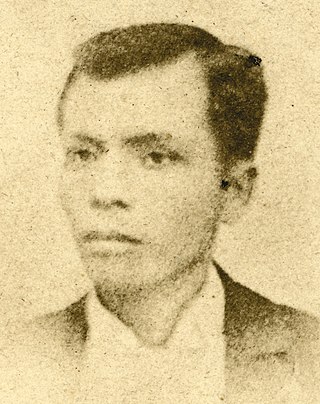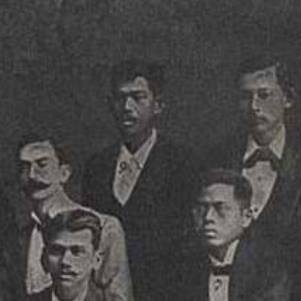
Emilio Aguinaldo y Famy was a Filipino revolutionary, statesman, and military leader who is the youngest president of the Philippines (1899–1901) and became the first president of the Philippines and of an Asian constitutional republic. He led the Philippine forces first against Spain in the Philippine Revolution (1896–1898), then in the Spanish–American War (1898), and finally against the United States during the Philippine–American War (1899–1901).

Andrés Bonifacio y de Castro was a Filipino Freemason and revolutionary leader. He is often called "The Father of the Philippine Revolution", and considered one of the national heroes of the Philippines. He was one of the founders and later the Kataastaasang Pangulo of the Kataastaasan, Kagalanggalangang Katipunan ng mga Anak ng Bayan or more commonly known as the "Katipunan", a movement which sought the independence of the Philippines from Spanish colonial rule and started the Tagalog Revolution. With the onset of the Revolution, Bonifacio reorganized the Katipunan into a revolutionary government, with himself as President (Pangulo) of a nation-state called "Haring Bayang Katagalugan", also "Republika ng Katagaluguan", where in "Tagalog" referred to all those born in the Philippine islands and not merely the Tagalog ethnic group. Hence, some historians have argued that he should be considered the First President of the Tagalogs instead of the Philippines; that is why he is not included in the current official line of succession.

The Philippine Revolution was a conflict waged by the Filipino revolutionaries against the Spanish colonial authorities in an attempt to win the archipelago's independence.

Pedro Alejandro Paterno y de Vera Ignacio was a Filipino politician infamous for being a turncoat. He was also a poet and a novelist.

Miguel Malvar y Carpio was a Filipino general who served during the Philippine Revolution and, subsequently, during the Philippine–American War. He assumed command of the Philippine revolutionary forces during the latter, following the capture of resistance leader Emilio Aguinaldo by the Americans in 1901. According to some historians, he could have been listed as one of the presidents of the Philippines but, as of 2022, is not recognized as such by the Philippine government.

Mariano M. Álvarez was a Filipino revolutionary and statesman.

The Pact of Biak-na-Bato, signed on December 15, 1897, created a truce between Spanish colonial Governor-General Fernando Primo de Rivera and the revolutionary leader Emilio Aguinaldo to end the Philippine Revolution. Aguinaldo and his fellow revolutionaries were given amnesty and monetary indemnity by the Spanish Government, in return for which the revolutionary government would go into exile in Hong Kong. Aguinaldo had decided to use the money to purchase advance firearms and ammunition later on return to the archipelago.

Mariano Trías y Closas is considered to be the first de facto Philippine Vice President of that revolutionary government established at the Tejeros Convention - an assembly of Philippine revolutionary leaders that elected officials of the revolutionary movement against the colonial government of Spain. When that assembly broke into factions, a truce known as the Pact of Biak-na-Bato was signed by the group and also recognized the elected officials and Trias as the vice president of Emilio Aguinaldo, who is also considered to be the first President of the Philippines. With the promulgation of the Malolos Constitution by the Malolos Convention, the First Philippine Republic was born. Under the Aguinaldo administration, Trias served in the cabinet initially as Secretary of Finance and, later, as Secretary of War.

The Tejeros Convention, also known as the Tejeros Assembly and the Tejeros Congress, was a meeting held on March 22, 1897, between Katipunan factions of Magdiwang and Magdalo in San Francisco de Malabon, Cavite that resulted in the creation of a new revolutionary government that took charge of the Philippine Revolution, replacing the Katipunan. It followed on a previous meeting now known as the Imus Assembly. Filipino historians consider the first presidential and vice presidential elections in Philippine history to have been held at this convention, although only Katipuneros were able to take part, and not the general populace.

The Political Constitution of 1899, informally known as the Malolos Constitution, was the constitution of the First Philippine Republic. It was written by Felipe Calderón y Roca and Felipe Buencamino as an alternative to a pair of proposals to the Malolos Congress by Apolinario Mabini and Pedro Paterno. After a lengthy debate in the latter part of 1898, it was promulgated on January 21, 1899.

The Republic of Biak-na-Bato was the second revolutionary republican government led by Emilio Aguinaldo during the Philippine Revolution that referred to itself as the Republic of the Philippines and was seated in what is now Biak-na-Bato National Park. The current designation was adopted by historians to avoid confusion with the name of the current Philippine government, which also refers to itself as the Republic of the Philippines, and with other past Philippine governments using the same designation.
Daniel Tirona y Tria was a Filipino politician. He became infamous for causing divisions within the Philippine revolutionary movement and for insulting and maligning Andres Bonifacio during the Tejeros Convention in 1897.
The sovereignty of the Philippines refers to the status of the Philippines as an independent nation. This article covers sovereignty transitions relating to the Philippines, with particular emphasis on the passing of sovereignty from Spain to the United States in the Treaty of Paris (1898), signed on December 10, 1898 to end the Spanish–American War. US President William McKinley asserted the United States' sovereignty over the Philippines on December 21, 1898 through his Benevolent Assimilation Proclamation.

The Hong Kong Junta was an organization formed as a revolutionary government in exile by Filipino revolutionaries after the signing of the Pact of Biak-na-Bato on December 15, 1897. It was headed by Emilio Aguinaldo and included high-level figures in the Philippine revolution against Spanish rule who accompanied Aguinaldo into exile in the Crown Colony of Hong Kong from the Philippines.
This is a list of notable events that happened in the Philippines in the year 1897.

General Mamerto Alejandrino Natividad was a haciendero and a Filipino military leader who led numerous successful battles during the Philippine Revolution against the Spaniards. He is credited with establishing army headquarters at Biak Na Bato, which today is a national park because of its historical significance. Together with Jose Clemente Zulueta, he wrote the proclamation entitled “To The Brave Sons of the Philippines”, which called for the expulsion of the friars from the Philippines. He was a signatory to the Biak Na Bato convention, but a steadfast dissenter to the Treaty of Biak Na Bato, which asked for peace and reforms. He preferred independence.

The Central Executive Committee in the Philippines was an insurgent revolutionary government temporarily established by Francisco Macabulos on April 17, 1898, shortly after the December 14, 1897, signing of the Pact of Biak-na-Bato. That pact established a truce between Spanish colonial authorities in the Philippines and the revolutionary Republic of Biak-na-Bato calling for the exile of Emilio Aguinaldo and other senior revolutionaries. The exiled revolutionaries formed the Hong Kong Junta, and the Central Executive Committee was intended to remain in existence in the Philippines "until a general government of the Republic in these islands shall again be established, with a constitution which provided for a President, Vice President, Secretary of War and Secretary of the Treasury.." The committee was dissolved shortly after Aguinaldo's May 19, 1898, return to the Philippines.

Salvador Estrella was a Filipino general who fought in the Philippine Revolution and the Philippine–American War. For his courage in battle, he earned the moniker "red blooded."
A revolutionary government or provisional government has been declared a number of times in the Philippines by insurgent groups.














